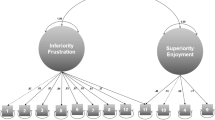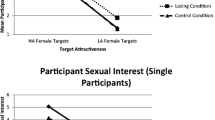Abstract
Researchers studying non-human females have highlighted the role of intrasexual resource competition. Here, we considered women’s intrasexual competitive attitudes toward rival derogation and self-promotion as a function of resource availability. Further, we tested the overarching hypothesis that both trait and state envy are complicit in the motivation to compete with intrasexual rivals in the face of resource scarcity. Using a resource availability prime, in Study 1 (N = 167), Canadian heterosexual young adult women in the resource scarcity condition held greater derogatory attitudes toward rivals when they were average or high in dispositional envy. However, contrary to our prediction for self-promotion, the interaction demonstrated that the resource scarcity prime was only effective among women low in envy. In Study 2 (N = 132), there were indirect effects for heightened state envy on the link between resource scarcity with stronger attitudes toward rival derogation. These findings highlight that resource availability exerts an important influence on women’s intrasexual rivalry, which appears to be driven, in part, by envy experienced in the face of perceived resource scarcity. At the trait level, high envy women might compete for scarcer resources by derogating rivals, whereas low envy women might do so via self-promotion.




Similar content being viewed by others
Notes
For descriptive purposes, we examined the sources of resource scarcity noted by the participants (note that participants were not limited in the number of factors recalled in the open-ended response). Roughly 60% identified monetary scarcity as having affected them, 25% noted food and toiletry scarcity, 9% noted employment scarcity, 8% identified healthcare scarcity, 15% noted housing scarcity, 13% noted transportation and gas scarcity, 8% identified clothing scarcity, 5% noted lack of time and energy due to experiencing poverty, 5% noted lack of social support, 5% had lacked electricity/water, 5% described effects of poverty on their physical or mental fitness, 7% noted concern for environmental resources, and 13% noted inability to afford leisure activities and travel.
References
Archer, J. (2009). Does sexual selection explain human sex differences in aggression? Behavioral and Brain Sciences, 32(3–4), 249–266. https://doi.org/10.1017/S0140525X09990951
Arnocky, S. (2016). Intrasexual rivalry among women. In T. K. Shackelford & V. A. Weekes-Shackelford (Eds.), Encyclopedia of evolutionary psychological science. New York: Springer. https://doi.org/10.1007/978-3-319-16999-6_1424-1
Arnocky, S., Perilloux, C., Cloud, J. M., Bird, B. M., & Thomas, K. (2016). Envy mediates the link between social comparison and appearance enhancement in women. Evolutionary Psychological Science, 2(2), 71–83. https://doi.org/10.1007/s40806-015-0037-1
Arnocky, S., & Piché, T. (2014). Cosmetic surgery as intrasexual competition: The mediating role of social comparison. Psychology, 5(10), 1197–1205. https://doi.org/10.4236/psych.2014.510132
Arnocky, S., Proietti, V., Ruddick, E. L., Côté, T. R., Ortiz, T. L., Hodson, G., & Carré, J. M. (2019). Aggression toward sexualized women is mediated by decreased perceptions of humanness. Psychological Science, 30(5), 748–756. https://doi.org/10.1177/0956797619836106
Arnocky, S., Sunderani, S., Miller, J., & Vaillancourt, T. (2012). Jealousy mediates the relationship between attractiveness comparison and females’ indirect aggression. Personal Relationships, 19(2), 290–303. https://doi.org/10.1111/j.1475-6811.2011.01362.x
Arnocky, S., Sunderani, S., & Vaillancourt, T. (2013). Mate-poaching and mating success in humans. Journal of Evolutionary Psychology, 11(2), 65–83. https://doi.org/10.1556/jep.11.2013.2.2
Arnocky, S., & Vaillancourt, T. (2017). Sexual competition among women: A review of the theory and supporting evidence. In M. L. Fisher (Ed.), The Oxford Handbook of Women and Competition (pp. 25–39). Oxford University Press.
Aiken, L. S., West, S. G., & Reno, R. R. (1991). Multiple regression: Testing and interpreting interactions. Sage.
Benenson, J. F. (2013). The development of human female competition: Allies and adversaries. Philosophical Transactions of the Royal Society b: Biological Sciences, 368(1631), 20130079. https://doi.org/10.1098/rstb.2013.0079
Benenson, J. F., Antonellis, T. J., Cotton, B. J., Noddin, K. E., & Campbell, K. A. (2008). Sex differences in children’s formation of exclusionary alliances under scarce resource conditions. Animal Behaviour, 76(2), 497–505. https://doi.org/10.1016/j.anbehav.2008.01.027
Blake, K. R. (2022). Attractiveness helps women secure mates, but also status and reproductively relevant resources. Archives of Sexual Behavior. https://doi.org/10.1007/s10508-021-01949-2 (Commentary).
Blake, K. R., Bastian, B., Denson, T. F., Grosjean, P., & Brooks, R. C. (2018). Income inequality not gender inequality positively covaries with female sexualization on social media. Proceedings of the National Academy of Sciences, 115(35), 8722–8727. https://doi.org/10.1073/pnas.1717959115
Blake, K. R., & Brooks, R. C. (2019). Status anxiety mediates the positive relationship between income inequality and sexualization. Proceedings of the National Academy of Sciences, 116(50), 25029–25033. https://doi.org/10.1073/pnas.1909806116
Bradshaw, H. K., & DelPriore, D. J. (2022). Beautification is more than mere mate attraction: Extending evolutionary perspectives on female appearance enhancement. Archives of Sexual Behavior. https://doi.org/10.1007/s10508-021-01952-7 (Commentary).
Bradshaw, H. K., Krems, J. A., & Hill, S. E. (2022). Resource availability differentially influences women’s perceptions of same- (versus cross-) sex others’ competitiveness. Advance online publication. https://doi.org/10.1037/ebs0000289
Burbank, V. K. (1987). Female aggression in cross-cultural perspective. Behavior Science Research, 21(1–4), 70–100. https://doi.org/10.1177/106939718702100103
Buunk, A., & Fisher, M. (2009). Individual differences in intrasexual competition. Journal of Evolutionary Psychology, 7(1), 37–48. https://doi.org/10.1556/jep.7.2009.1.5
Buunk, A. P., Fornari Bucksath, A., & Cordero, S. (2017). Intrasexual competitiveness and personality traits: A study in Uruguay. Personality and Individual Differences, 108, 178–181. https://doi.org/10.1016/j.paid.2016.11.060
Camera, G., Deck, C., & Porter, D. (2020). Do economic inequalities affect long-run cooperation and prosperity? Experimental Economics, 23(1), 53–83. https://doi.org/10.1007/s10683-019-09610-5
Campbell, A. (1999). Staying alive: Evolution, culture, and women’s intrasexual aggression. Behavioral and Brain Sciences, 22(2), 203–252. https://doi.org/10.1017/S0140525X99001818
Campbell, A., Muncer, S., & Bibel, D. (1998). Female-female criminal assault: An evolutionary perspective. Journal of Research in Crime and Delinquency, 35(4), 413–428. https://doi.org/10.1177/0022427898035004003
Campbell, A. (1995). A few good men: Evolutionary psychology and female adolescent aggression. Ethology and Sociobiology, 16, 99–123. https://doi.org/10.1016/0162-3095(94)00072-F
Cashden, E. (1998). Are men more competitive than women? British Journal of Social Psychology, 37(2), 213–229. https://doi.org/10.1111/j.2044-8309.1998.tb01166.x
Clutton-Brock, T. H., & Parker, G. A. (1995). Sexual coercion in animal societies. Animal Behaviour, 49(5), 1345–1365. https://doi.org/10.1006/anbe.1995.0166
Cross, C., & Campbell, A. (2014). Violence and aggression in women. In T. Shackelford & R. Hansen (Eds.), The evolution of violence (pp. 211–232). Springer.
Daly, M., & Wilson, M. (2001). Risk-taking, intrasexual competition, and homicide. In J. A. French, A. C. Kamil, & D. W. Leger (Eds.), Evolutionary psychology and motivation (pp. 1–36). University of Nebraska Press.
Darwin, C. (1871). The descent of man and selection in relation to sex. John Murray.
DelPriore, D. J., Hill, S. E., & Buss, D. M. (2012). Envy: Functional specificity and sex- differentiated design features. Personality and Individual Differences, 53(3), 317–322. https://doi.org/10.1016/j.paid.2012.03.029
Durante, K. M., Griskevicius, V., Hill, S. E., Perilloux, C., & Li, N. P. (2011). Ovulation, female competition, and product choice: Hormonal influences on consumer behavior. Journal of Consumer Research, 37(6), 921–934. https://doi.org/10.1086/656575
Ejelöv, E., & Luke, T. J. (2020). “Rarely safe to assume”: Evaluating the use and interpretation of manipulation checks in experimental social psychology. Journal of Experimental Social Psychology, 87, 103937. https://doi.org/10.1016/j.jesp.2019.103937
Fisher, M. L. (2004). Female intrasexual competition decreases female facial attractiveness. Proceedings of the Royal Society B: Biological Sciences, 271(Suppl. 5), S283–S285. https://doi.org/10.1098/rsbl.2004.0160
Fisher, M. L. (2013). Women’s intrasexual competition for mates. In M. L. Fisher, J. R. Garcia, & R. Sokol Chang (Eds.), Evolution’s empress: Darwinian perspectives on the nature of women (pp. 19–42). Oxford University Press.
Fisher, M., & Cox, A. (2011). Four strategies used during intrasexual competition for mates. Personal Relationships, 18(1), 20–38. https://doi.org/10.1111/j.1475-6811.2010.01307.x
Fritz, M. S., & MacKinnon, D. P. (2007). Required sample size to detect the mediated effect. Psychological Science, 18(3), 233–239. https://doi.org/10.1111/j.1467-9280.2007.01882.x
Georgiev, A. V., Klimczuk, A. C., Traficonte, D. M., & Maestripieri, D. (2013). When violence pays: A cost-benefit analysis of aggressive behavior in animals and humans. Evolutionary Psychology, 11(3), 678–699. https://doi.org/10.1177/147470491301100313
Griskevicius, V., Ackerman, J. M., Cantú, S. M., Delton, A. W., Robertson, T. E., Simpson, J. A., & Tybur, J. M. (2013). When the economy falters, do people spend or save? Responses to resource scarcity depend on childhood environments. Psychological Science, 24(2), 197–205. https://doi.org/10.1177/0956797612451471
Griskevicius, V., Tybur, J. M., Gangestad, S. W., Perea, E. F., Shapiro, J. R., & Kenrick, D. T. (2009). Aggress to impress: Hostility as an evolved context-dependent strategy. Journal of Personality and Social Psychology, 96(5), 980–994. https://doi.org/10.1037/a0013907
Hauser, D. J., Ellsworth, P. C., & Gonzalez, R. (2018). Are manipulation checks necessary? Frontiers in Psychology, 9, 998. https://doi.org/10.3389/fpsyg.2018.00998
Hayes, A. F. (2013). Introduction to mediation, moderation, and conditional process analysis. The Guilford Press.
Hess, N. H., & Hagen, E. H. (2021). Competitive gossip: The impact of domain, resource value, resource scarcity and coalitions. Philosophical Transactions of the Royal Society B, 376(1838), 20200305. https://doi.org/10.1098/rstb.2020.0305
Hill, S. E., & Buss, D. M. (2006). Envy and positional bias in the evolutionary psychology of management. Managerial and Decision Economics, 27(2–3), 131–143. https://doi.org/10.1002/mde.1288
Hill, S. E., & Buss, D. M. (2008). The evolutionary psychology of envy. In R. H. Smith (Ed.), Envy: Theory and research (pp. 60–70). Oxford University Press.
Hill, S. E., DelPriore, D. J., & Vaughan, P. W. (2011). The cognitive consequences of envy: Attention, memory, and self-regulatory depletion. Journal of Personality and Social Psychology, 101(4), 653–666. https://doi.org/10.1037/a0023904
Hill, S. E., Rodeheffer, C. D., Griskevicius, V., Durante, K., & White, A. E. (2012). Boosting beauty in an economic decline: Mating, spending, and the lipstick effect. Journal of Personality and Social Psychology, 103(2), 275–291. https://doi.org/10.1037/a0028657
Hrdy, S. B. (2013). The ‘one animal in all creation about which man knows the least.’ Philosophical Transactions of the Royal Society b: Biological Sciences, 368(1631), 20130072. https://doi.org/10.1098/rstb.2013.0072
Hurst, A. C. (2018). The effect of economic scarcity on women’s direct aggression toward ovulating women. Texas Tech University. Unpublished doctoral dissertation.
Karimi-Malekabadi, F., Ghanbarian, E., Afhami, R., & Chegeni, R. (2019). Theory-driven assessment of intrasexual rivalry. Evolutionary Psychological Science, 5(3), 286–293. https://doi.org/10.1007/s40806-018-00185-7
Keys, E., & Bhogal, M. S. (2018). Mean girls: Provocative clothing leads to intra-sexual competition between females. Current Psychology, 37, 543–551. https://doi.org/10.1007/s12144-016-9536-x
Kristofferson, K., Lamberton, C., & Dahl, D. W. (2018). Can brands squeeze wine from sour grapes? The importance of self-esteem in understanding envy’s effects. Journal of the Association for Consumer Research, 3(2), 229–239. https://doi.org/10.1086/697082
Lange, J., Hagemeyer, B., Lösch, T., & Rentzsch, K. (2020). Accuracy and bias in the social perception of envy. Emotion, 20(8), 1399–1410. https://doi.org/10.1037/emo0000652
Lange, J., & Crusius, J. (2015). Dispositional envy revisited: unraveling the motivational dynamics of benign and malicious envy. Personality and Social Psychology Bulletin, 41(2), 284–294. https://doi.org/10.1177/0146167214564959
Lin, R., & Utz, S. (2015). The emotional responses of browsing Facebook: Happiness, envy, and the role of tie strength. Computers in Human Behavior, 52, 29–38. https://doi.org/10.1016/j.chb.2015.04.064
Mago, S. D., & Razzolini, L. (2019). Best-of-five contest: An experiment on gender differences. Journal of Economic Behavior & Organization, 162, 164–187. https://doi.org/10.1016/j.jebo.2019.04.015
McKelvie, L., Locke, A., Albert, G., Minor, M., MacKinnon, M., Hodges-Simeon, C. R., & Arnocky, S. (2022). Perceived mate scarcity leads to increased willingness to mate poach. The Journal of Sex Research. https://doi.org/10.1080/00224499.2021.2005762
Mola, D. J., Saavedra, B. A., & Reyna, C. (2014). Evidences of reliability and validity of the dispositional envy scale in Argentinian samples. International Journal of Psychological Research, 7(1), 73–80. https://doi.org/10.21500/20112084.668
Morgan, R., Locke, A., & Arnocky, S. (2022). Envy mediates the relationship between physical appearance comparison and women’s intrasexual gossip. Evolutionary Psychological Science, 8(2), 148–157. https://doi.org/10.1007/s40806-021-00298-6
Parrott, W. G., & Smith, R. H. (1993). Distinguishing the experiences of envy and jealousy. Journal of Personality and Social Psychology, 64(6), 906–920. https://doi.org/10.1037/0022-3514.64.6.906
Pollet, T. V., Nettle, D., & Nelissen, M. (2007). Maternal grandmothers do go the extra mile: Factoring distance and lineage into differential contact with grandchildren. Evolutionary Psychology, 5(4), 832–843. https://doi.org/10.1177/147470490700500412
Piccoli, V., Foroni, F., & Carnaghi, A. (2013). Comparing group dehumanization and intra-sexual competition among normally ovulating women and hormonal contraceptive users. Personality and Social Psychology Bulletin, 39, 1600–1609. https://doi.org/10.1177/0146167213499025
Reyes, E., & Klug, H. (2021). Parental investment and sexual selection. In T. K. Shackelford & V. A. Weekes-Shackelford (Eds.), Encyclopedia of evolutionary psychological science. Cham: Springer. https://doi.org/10.1007/978-3-319-19650-3_1691
Rosvall, K. A. (2011). Intrasexual competition in females: Evidence for sexual selection? Behavioral Ecology, 22(6), 1131–1140. https://doi.org/10.1093/beheco/arr106
Roux, C., Goldsmith, K., & Bonezzi, A. (2015). On the psychology of scarcity: When reminders of resource scarcity promote selfish (and generous) behavior. Journal of Consumer Research, 42(4), 615–631. https://doi.org/10.1093/jcr/ucv048
Sánchez-Rodríguez, Á., Rodríguez-Bailón, R., & Willis, G. B. (2022). Economic inequality affects perceived normative values. Group Processes & Intergroup Relations, 25(1), 211–226. https://doi.org/10.1177/1368430220968141
Schmitt, D. P., & Buss, D. M. (1996). Strategic self-promotion and competitor derogation: Sex and context effects on the perceived effectiveness of mate attraction tactics. Journal of Personality and Social Psychology, 70(6), 1185–1204. https://doi.org/10.1037/0022-3514.70.6.1185
Shackelford, T., & Goetz, A. (2009). Sexual conflict in humans: Evolutionary consequences of asymmetric parental investment and paternity uncertainty. Animal Biology, 59(4), 449–456. https://doi.org/10.1163/157075509X12499949744342
Sheyd, G. (2018). Intrasexual Competition. In T. K. Shackelford & V. A. Weekes-Shackelford (Eds.), Encyclopedia of evolutionary psychological science. Springer. https://doi.org/10.1007/978-3-319-16999-6_1406-1
Smith, R. H., & Kim, S. H. (2007). Comprehending envy. Psychological Bulletin, 133(1), 46–64. https://doi.org/10.1037/0033-2909.133.1.46
Smith, R. H., Parrott, W. G., Diener, E. F., Hoyle, R. H., & Kim, S. H. (1999). Dispositional envy. Personality and Social Psychology Bulletin, 25(8), 1007–1020. https://doi.org/10.1177/01461672992511008
Stockley, P., & Bro-Jørgensen, J. (2011). Female competition and its evolutionary consequences in mammals. Biological Reviews, 86(2), 341–366. https://doi.org/10.1111/j.1469-185X.2010.00149.x
Sutter, M., Bosman, R., Kocher, M. G., & van Winden, F. (2009). Gender pairing and bargaining–Beware the same sex! Experimental Economics, 12(3), 318–331. https://doi.org/10.1007/s10683-009-9217-9
Trivers, R. L. (1972). Parental investment and sexual selection. In B. Campbell (Ed.), Sexual selection and the descent of man 1871–1971 (pp. 180–230). Aldine.
Vaillancourt, T. (2013). Do human females use indirect aggression as an intrasexual competition strategy? Philosophical Transactions of the Royal Society of London b, Biological Sciences, 368(1631), 20130080. https://doi.org/10.1098/rstb.2013.0080
Vaillancourt, T., & Davis, A. C. (2021). The status, personality, and aggression study. University of Ottawa. Unpublished raw data.
van de Ven, N., Zeelenberg, M., & Pieters, R. (2012). Appraisal patterns of envy and related emotions. Motivation and Emotion, 36(2), 195–204. https://doi.org/10.1007/s11031-011-9235-8
Vaillancourt, T., & Sharma, A. (2011). Intolerance of sexy peers: Intrasexual competition among women. Aggressive Behavior, 37, 569–577. https://doi.org/10.1002/ab.2041
Vrabel, J. K., Zeigler-Hill, V., & Southard, A. C. (2018). Self-esteem and envy: Is state self-esteem instability associated with the benign and malicious forms of envy? Personality and Individual Differences, 123, 100–104. https://doi.org/10.1016/j.paid.2017.11.001
Watson, N. L., & Simmons, L. W. (2010). Reproductive competition promotes the evolution of female weaponry. Proceedings of the Royal Society B: Biological Sciences, 277(1690), 2035–2040. https://doi.org/10.1098/rspb.2009.2335
Wilson, M. L., Boesch, C., Fruth, B., Furuichi, T., Gilby, I. C., Hashimoto, C., & Wrangham, R. W. (2014). Lethal aggression in Pan is better explained by adaptive strategies than human impacts. Nature, 513(7518), 414–417. https://doi.org/10.1038/nature13727
Zhuang, J. -Y., & Wang, J. -X. (2014). Women ornament themselves for intrasexual competition near ovulation, but for intersexual attraction in luteal phase. PLoS ONE, 9(9), e106407. https://doi.org/10.1371/journal.pone.0106407
Funding
Data collection costs supported by a grant from the Natural Sciences and Engineering Research Council of Canada (NSERC) Discovery Development Grant awarded to Steven Arnocky (file # RGPIN-2019-05988).
Author information
Authors and Affiliations
Contributions
S. Arnocky conceptualized the design and collected the data, and S. Arnocky and A. Davis conducted analyses and wrote the manuscript, with consultation and editing by T. Vaillancourt.
Corresponding author
Ethics declarations
Ethics Approval
This research was performed in accordance with the Canadian tri-council policy statement on ethical conduct for research involving humans – TCPS 2. Approval was granted by the Ethics Committee of Nipissing University (file: 101912 – 30439).
Consent to Participate
Informed consent was obtained from all individual participants included in the study.
Consent to Publish
Participants provided consent for data to be published.
Conflict of Interest
The authors declare no competing interests.
Additional information
Publisher's Note
Springer Nature remains neutral with regard to jurisdictional claims in published maps and institutional affiliations.
Rights and permissions
Springer Nature or its licensor holds exclusive rights to this article under a publishing agreement with the author(s) or other rightsholder(s); author self-archiving of the accepted manuscript version of this article is solely governed by the terms of such publishing agreement and applicable law.
About this article
Cite this article
Arnocky, S., Davis, A.C. & Vaillancourt, T. Resource Scarcity Predicts Women’s Intrasexual Competition: The Role of Trait and State Envy. Evolutionary Psychological Science 9, 135–147 (2023). https://doi.org/10.1007/s40806-022-00344-x
Received:
Revised:
Accepted:
Published:
Issue Date:
DOI: https://doi.org/10.1007/s40806-022-00344-x




